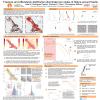Poster #137, Fault and Rupture Mechanics (FARM)
Evidence for slow slip in Mecca Hills, CA, from microstructural and (U-Th)/He analysis of heterogeneous hematite coatings on shallow fault surfaces
Poster Image:

Poster Presentation
2020 SCEC Annual Meeting, Poster #137, SCEC Contribution #10564 VIEW PDF
s in the exhumed Painted Canyon fault (PCF) in Mecca Hills, CA. Ten samples collected from five locations in the PCF have ubiquitous hematite slip surfaces with a range of orientations, textures, and crystal habits. SEM reveals multiple hematite morphologies, such as previously recognized high-aspect ratio plates, as well as serrated, stubby, cuspate or petal-like, and euhedral hexagonal plates. Hematite occurs (1) interlayered with calcite and phyllosilicates, (2) in microscale injection veins, (3) in layers of hematite-cemented breccia with a decreasing clast abundance and size toward the slip surface, (4) as tails on clasts, and (5) in reworked hematite clasts. Injection veins imply precipitation by pore-fluid overpressure. Hematite displays S-C fabrics, intra- and inter-plate folds, and shape preferred orientation that suggest ongoing deformation. Initial hematite (U-Th)/He dates document the timing of Pleistocene mineralization (Moser et al., 2017; EPSL). Reproducible mean dates for individual fault surfaces, different dates on separate slip surfaces, and the absence of recrystallization textures indicative of coseismic frictional heat support post-mineralization slow slip. Collectively these observations indicate multiple episodes of hematite precipitation, fault reactivation, and slow slip. On-going integrated hematite (U-Th)/He thermochronometry and textural analysis will evaluate this hypothesis with an expanded dataset from a cross-fault outside of the main PCF zone and high-density slip surfaces from individual outcrops. Future field work will document spatial relationships of hematite slip surfaces across specific basement lithologies and clay fault gouge, and the associated extent of alteration and fault reactivation.
SHOW MORE
SHOW MORE



























































